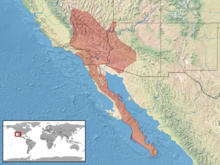Crotalus mitchellii
| Crotalus mitchellii | |
|---|---|

| |
| Scientific classification | |
| Domain: | Eukaryota |
| Kingdom: | Animalia |
| Phylum: | Chordata |
| Class: | Reptilia |
| Order: | Squamata |
| Suborder: | Serpentes |
| Family: | Viperidae |
| Genus: | Crotalus |
| Species: | C. mitchellii
|
| Binomial name | |
| Crotalus mitchellii (Cope, 1861)
| |

| |
| Synonyms[2] | |
| |
Crotalus mitchellii is a
Description
Generally, C. mitchelli does not exceed 100 cm (39 in) in total length (including tail), with large males measuring between 90 and 100 cm (35 and 39 in). The race on Isla Ángel de la Guarda is known to become larger, the maximum recorded length for a specimen there being 136.7 cm (53.8 in). In contrast, the population on El Muerto Island only reaches a maximum of 63.7 cm (25.1 in) in length.[3] On the back are about thirty sometimes vague markings often in the form of crossbars. The Speckled Rattlesnake, also called the Panamint Rattlesnake, is sometimes erroneously called the Tiger Rattlesnake because of these. Other times the markings are clearly defined geometric shapes - diamonds, hexagons, hourglasses - which vary in color from snake to snake but are always darker than the ground color. Normally there is a community coloration based on the snakes' specific rock setting. The whole effect: an individual snake looks like it had been formed from granite, a protective coloration it uses with great effect, and that is also quite beautiful when examined, as one might a work of art, against a contrasting background.[8]
Geographic range
C. mitchelli is found in the southwestern United States and in northwestern Mexico. In the US, its range includes east-central and southern
The
Subspecies and taxonomy
| Subspecies[7] | Taxon author[7] | Common name[9] | Geographic range[9] |
|---|---|---|---|
| C. m. mitchellii | (Cope, 1861) | San Lucan speckled rattlesnake | Mexico, in Baja California Sur and on the islands of Santa Margarita, Cerralvo, Espíritu Santo, San José, Monserrate, and Carmen |
| C. m. muertensis | Klauber, 1949 | El Muerto Island speckled rattlesnake | Mexico, on the island of Isla El Muerto |
Grismer (1999) argued that
Conservation status
The nominate subspecies (C. m. mitchellii ) is classified as "
References
- ^ . Retrieved 6 October 2021.
- ^ ISBN 1-893777-01-4(volume).
- ^ ISBN 0-8014-4141-2.
- ISBN 0-486-26629-X.
- Ditmars RL(1933). Reptiles of the World. Revised Edition. New York: The MacMillan Company. 329 pp. 89 plates.
- ISBN 978-1-4214-0135-5. ("Mitchell, S.W.", p. 180).
- ^ a b c "Crotalus mitchellii ". Integrated Taxonomic Information System. Retrieved 25 February 2007.
- ISBN 978-0-394-48882-0.
- ^ ISBN 0-520-21056-5.
- ^ Douglas ME, Douglas MR, Schuett GW, Porras LW, Thomason BL (2007). "Genealogical concordance between mitochondrial and nuclear DNAs supports species recognition of the Panamint rattlesnake (Crotalus mitchellii stephensi )". Copeia 2007: 920–932.
- ^ Meik JM, Streicher JW, Lawing AM, Flores-Villela O, Fujita MK (2015). "Limitations of Climatic Data for Inferring Species Boundaries: Insights from Speckled Rattlesnakes". PLoS ONE 10 (6): e0131435. doi:10.1371/journal.pone.0131435
- ^ 2001 Categories & Criteria (version 3.1) at the IUCN Red List. Accessed 13 September 2007.
Further reading
- Cope ED (1861). "Contributions to the Ophiology of Lower California, Mexico and Central America". Proceedings of the Academy of Natural Sciences of Philadelphia 13: 292-306. (Caudisona mitchellii, new species, pp. 293–294).

